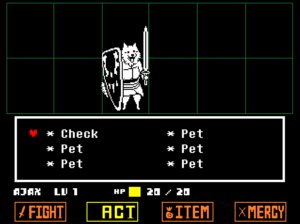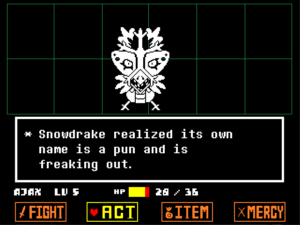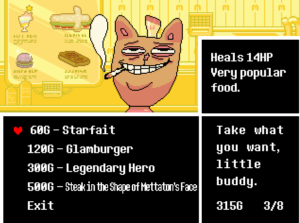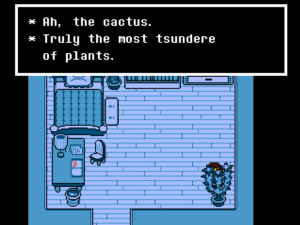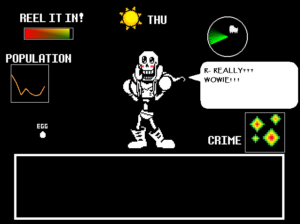
Undertale is a roleplaying game designed, written, and composed by Toby Fox. Toby himself had his humble beginnings as a forum member of Starmen.net, an Earthbound fansite. His first actual game release was the Earthbound Halloween Hack, a submission for a Starmen Halloween contest.
It was fairly well-received by fans of the series, especially due to its excellent soundtrack. After this, Toby went on to produce music for the webcomic, Homestuck, and later would announce a Kickstarter for Undertale, which managed to raise $50,000~ dollars, despite asking for only $5,000.
Undertale wears its Earthbound influences on its sleeve, taking on a very similar style, while still remaining unique in its own way. Characters are imaginative, with some insane monster designs that range from funny and charming, to absolutely terrifying. It’s certainly a pretty game to look at, no matter which way you slice it.
The soundtrack is just legendary, with some of the coolest songs I’ve ever heard in a game. Megalovania and Bonetrousle are my favorites, but there’s really not a single track that I didn’t love. Each song fits perfectly into the game, capturing the mood of the events transpiring on-screen with brilliant efficiency. The score ranges from whimsical and goofy to emotional and inspiring, and I will likely be listening to Undertale’s music for years to come. It’s just that good.
Gameplay-wise, this title is an interesting mashup of genres. When you enter into combat, either via scripted events or random encounters, you’re thrust into what seems to be a typical turn-based affair. However, when an enemy attacks you, you’ll notice just how unique Undertale’s battle mechanics are. Enemies will fire a series of projectiles at you, whether they be bullets, tears, or even dogs. As a tiny red heart, you have to avoid these attacks, or risk taking damage.
Your attacks are much more straightforward, with a timing-based minigame dictating how much damage you do. If you center the bar directly in the middle, you score a critical hit! Interestingly enough, the game discourages you from wantonly killing things, instead conditioning you from the very beginning to use your ACT function in battles.
The ACT button brings up a series of non-lethal options for dealing with enemies. Some of these options involve simply talking with the many creatures throughout the game, though this varies depending on the monster. Through the use of this mechanic, the player is able to talk down their adversaries and pacify them, ultimately sparing their lives.
The only way to get the, “Good,” ending in Undertale is to engage in what’s known as a Pacifist Run, where one avoids killing anything the whole game through. There are also, “Neutral,” and, “Bad,” endings, the latter of which is achieved when the player simply kills everything they come across. This is known as a Genocide Run, and interestingly enough, playing the game this way completely alters the storyline.
The narrative itself is well-told, with many likeable characters throughout. Essentially, the story takes place after a war between monsters and humans. Humans were ultimately victorious, magically sealing the monsters underground while they took control of the surface. The only weak point in the barrier is through Mount Ebott, and it is through this hole that the main character falls, beginning the events of Undertale.
I’d prefer not to spoil any more of the story, as it simply has to be experienced firsthand. I will discuss the characters, though, and how engaging they are. You meet up with a plethora of monsters in Undertale, ranging from one-off encounters with enemies, to meaningful friendships and bonds with some of the main cast.
Among these friends are Toriel, a motherly goat monster who wants to shield you from the dangers of the underground, though she ends up selfishly trying to keep you from escaping as well. There are also Papyrus and Sans, named after the fonts in which they speak, who are a duo of wise-cracking skeleton brothers.
These characters, among plenty of others, make the story truly come to life. Most of the monsters come off as goofy at first, but their depth is revealed more and more as you interact with them. After a successful Pacifist Run, it was impossible for me to imagine going back through the game and killing all of them. The thought barely even crossed my mind.
That’s a lot of praise for the game, though. I haven’t gotten into what I dislike about Undertale. This is mostly due to the fact that I have very little to complain about. If I had to nitpick, and I mean really nitpick, I think I’d have to say it’s a tiny bit too short, with the game clocking in around 5-6 hours long. To be honest, this isn’t much of a problem for me, but people who are looking for a lengthy role-playing experience might be a tad disappointed.
Another potential caveat is that the game is incredibly accessible for not only fledgling RPG fans, but people who aren’t particularly into gaming as a whole. While I consider this to be a good thing, there are certainly RPG purists out there who might scoff at the lack of any hardcore mechanics in the game. And that’s a fair assessment—though, I still think there’s plenty here to enjoy for someone with that mindset.
All in all, Undertale is a gem that I hold dear to my heart. I had very little idea of what to expect going in, and was pleasantly surprised at every turn. The music is marvelous, the gameplay fun and engaging. The story is fraught with twists and turns, and the characters are just so damned likable.
I found myself smiling through a majority of my time with this game, unable to put it down until I’d beaten it. For only $10 USD (or your regional equivalent) on Steam, it’s hard not to recommend at least giving it a try. For me, it might just be my game of the year.
Undertale was reviewed on the PC using a digital copy provided by Toby Fox. You can find additional information about Niche Gamer’s review/ethics policy here.
The Verdict: 9.75
The Good:
- Probably one of the best soundtracks ever.
- Amazing characters, a story full of twists and turns.
- Lovely pixel art, with imaginative creature designs.
- A unique take on combat, mixing bullet hell with traditional turn-based battles.
- Hilarious writing that can turn on a dime and make you feel feelings.
- Goat mom.
The Bad:
- Might not appeal as much to hardcore RPG fans, due to its accessibility.
- Could be considered too short, though the replay value is very high.
